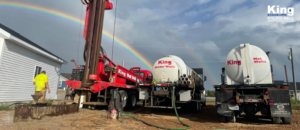
Questions About Your Water Well
When you’re out of water, it can be caused by a range of issues. The simplest thing you can do it check your breaker and fuses. Second, do you have water anywhere? If so, it may be a plumbing issue. Look to see what your pressure gauge reads. Most importantly, only trained professionals should work on well components. There are immediate risks of electrical shock.
Be sure to contact us if you do not have water!
Check your pressure gauge. It should read somewhere between 40-60psi. Think about when you notice the low pressure. Is it when you use a lot of water? This could be indication the well isn’t producing or the pump is worn out. Is it all the time and the pressure reads 40-60psi? Check filters, bypass your water softner. If the pump runs a lot it could indicate a break in a waterline and you’re losing water somewhere.
Generally they’re classified by 2″ deep or shallow, 4″ steel or galvanized steel and 5″ PVC. If you can see your pump and motor it’s a 2″ well. If there’s a pipe sticking about 1′ out of the ground it’s newer, possibly a 4″ or 5″ well. 5″ PVC plastic wells are most common now. They provide more room around the pump and motor, are faster to construct and don’t rust. Steel wells constructed by cable tool method are great for areas with limited water bearing formations and flowing wells.
New wells generally range from $4000 to $8000. The depth of the well and static water level are big factors. A deeper well with lower static water level may require a larger pump, motor and tank to lift the water and have appropriate storage. Drillers prices and payment options can vary widely. It’s best to find a company you feel very comfortable with. Not all wells are created equal. Good companies stand behind their work. Remember, wells are long term investments.
It’s always a good idea to have your water tested. You can elect to test for bacteria, heavy metals, nitrates and many other things. Each new well is required to pass a basic test.
Most wells operate between 40-60psi. Constant pressure is a well system that can use a mechanical or electronic device that gives you 60psi all the time. Common devices are cycle stop valves, VFDs or variable frequency drives.
It typically takes 1 to 4 days for the installation to be complete. However, it can take up to an additional 24 – 36 hours for water testing results to ensure the water is safe to drink.
Have a Different Question?
Contact us any way that is most convenient for you!
View more Water Well Maintenance, service, and installation information

Getting Your Water Well System Ready for Spring
Although water well systems are built to function on their own, there are some routine maintenance tasks that homeowners should do to ensure that the

Caring for Your Water System During Winter
Water well systems are not something that you want to ignore or forget about during the cold winter months. Although most systems are built and
The Importance Of Irrigation For Residential And Commercial Properties
Proper irrigation is essential for maintaining the health and beauty of both residential and commercial landscapes. Whether you’re a homeowner looking to keep your garden
Do's
- Pump Your System Frequently
- Maintain Your Drain Field
- Properly Dispose of Waste
- Use Water Efficiently
✓ Pump Your System Frequently
It is best to have household septic systems are pumped every two to three years. When we come out to pump your tank let us know how many years it’s been since so we can tell you how often your septic system needs to be pumped in the future. Frequent pumping often prevents premature failure.
✓ Maintain Your Drain Field
To maintain your drain field, avoid planting gardens, bushes, and trees nearby. When roots grow deep, they can bump against your septic system. You should also avoid parking cars over your drain field.
✓ Properly Dispose of Waste
Be careful with what you put down the garbage disposal. To avoid clogging your system up, try not to put cooking grease, coffee grounds, and chemicals down the disposal.
✓ Use Water Efficiently
The more water you waste with, the more water will enter your septic system, which can lead to potential drain field flooding. The easiest way to prevent wasting water is by using high-efficiency appliances. Look for Energy Star washing machines, toilets, and other appliances, which use 50 percent less water than other outdated appliances.
Dont's
- Flush Items Down Your Toilet
- Pour Chemicals Down Your Drain
- Waste Water
- Install Rainwater Drainage Nearby
✗ Flush Items Down Your Toilet
Avoid flushing anything down the toilet that isn’t toilet paper, including items described as “flushable”, such as wipes.
✗ Pour Chemicals Down Your Drain
Whether you’re at the kitchen sink or the bathroom shower, avoid pouring chemicals, oil, grease, and toxic liquids down the drain. Chemical drain and pipe cleaners can also be damaging to septic systems. The liquid hydrochloric acid that’s found in many of these drain cleaners is strong enough to eat away at pipes and even metal parts.
✗ Waste Water
Wasting water is the easiest ways to diminish the efficiency of a septic system. Some of the simplest ways to avoid wasting water are to invest in Energy Star appliances, fix leaking faucets, and repair running toilets.
✗ Install Rainwater Drain Systems Nearby
Do not keep heavy equipment, gardens/trees, or excess rainwater on your drain field area. Excess rainwater from a drainage system, can cause water to accumulate near your drain field which will slow down your septic system’s treatment process.
